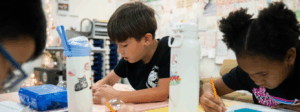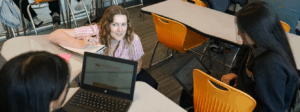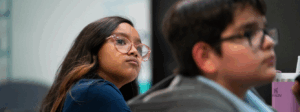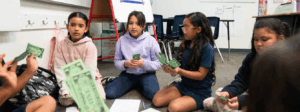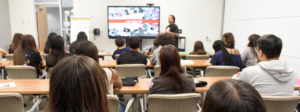The science of reading has been a hot topic among educators, academics, and parents over the past few years, as states and school systems rush to find solutions to the country’s reading crisis. And the urgency is real: 37% of fourth graders scored below basic on NAEP reading in 2022, and just a third of fourth graders scored proficient. Additionally, 65 to 70% of students need systematic instruction in foundational skills to become proficient readers.
At TNTP, we embraced the science of reading movement early on, and have been partnering with states and school systems nationwide to bring the science of reading to life in every classroom. We believe that strong reading instruction should be systematic and robust, covering multiple components and strategies for reading. From educator training to curriculum selection to practical implementation support and coaching, we build leader and educator knowledge about evidence-based instruction and shift long-held mindsets about what works for emerging readers.
What is the science of reading?
According to our colleagues at the Reading League, “the science of reading is a vast, interdisciplinary body of scientifically based research about reading and issues related to reading and writing.”
The science of reading is not a single program or technique, though it does provide evidence for a set of techniques that can best support all students to become proficient readers. It also addresses more than just foundational skills. It includes word recognition, foundational skills, and language comprehension skills like building vocabulary, content knowledge, and comprehension, and emerging models also point to the importance of cultural knowledge, motivation and engagement, and executive function to fluent reading.
The bottom line: The science of reading is a body of evidence that tells us how students learn to read, and includes evidence supporting phonological and phonemic awareness, phonics and word recognition, fluency, vocabulary, content knowledge development, and comprehension. To meet the needs of all learners in the science of reading approach, students must have access to complex, culturally and linguistically relevant texts.
What is TNTP’s position on the science of reading?
We are proud of the impact of our science of reading-based work in places like Tennessee, Massachusetts, and Texas, where thorough training, high-quality instructional materials, and hands-on implementation support have led to significant student progress.
While the Science of Reading has given us a strong foundation to ensure more students receive evidence-based instruction in literacy, we realize that our efforts thus far are not enough to achieve equity and economic and social mobility for all students, particularly for populations who have been furthest from opportunity. In response, we are evolving our approach to meet the needs of our emergent bilingual, multilingual, bidialectal learners, students with learning and thinking differences including those with language disorders, to bring the science of reading to life for all learners.
With that awareness top of mind, we firmly believe that all educators must consider the context in which they’re working and ask themselves: Who are the individual students we are serving? What are their assets and their needs? How can we adjust our approaches to best serve all of our students?
Science of reading instruction provides a solid foundation for all learners, but it is not a one-size-fits-all prescription for everything that every learner needs. Literacy is much more than just reading. True literacy requires equal attention to speaking, listening, reading, and writing and includes attention to cross-linguistic connections for our multilingual learners.
Multilingual learners, bidialectal learners, and students with learning and thinking differences may need more instruction in some elements of language and literacy and less instruction in others than their peers, based on their linguistic and cognitive assets and needs.
What is TNTP’s approach to science of reading training and implementation?
An increasing number of states and school systems have been legislating science of reading educator training and aligned instructional materials. These are great first steps, but without implementation support, they won’t produce the results students deserve.
Educators benefit from understanding the theory behind the science of reading, but that knowledge does not seamlessly transfer to classroom instructional practice—nor does it provide guidance on how to implement the reading curriculum purchased by the school system.
That’s why we strongly recommend a third component: implementation support. Teachers need and deserve support and coaching to apply what they’ve learned through high-quality learning experiences (whether with us or another provider), along with the high-quality instructional materials selected by their district. We partner with teachers to help them figure out how to use high-quality instructional materials with integrity and do what it takes to ensure that every student in their classroom can access the instruction, no matter where they start.
Given that most teacher preparation programs do not yet train future educators in the science of reading, it’s only logical that current educators need time and support to process this significant shift. We wouldn’t expect someone to take a college course about football, pick up an NFL playbook, and score a touchdown in their first game. Everyone needs a good coach and some practice.
Why does the science of reading matter?
The science of reading is a key component of economic and social mobility for all young people. When more students have a strong foundation in literacy, more students will be able to engage with rigorous, grade-level work and assignments. As we concluded in our 2018 report, The Opportunity Myth, ensuring kids have access to grade-appropriate assignments is one of the essential ways to improve their long-term outcomes.
When students master foundational literacy skills, the world of learning opens for them—for life. We believe nothing is more important than helping young people reach their goals in school, post-secondary learning, and the careers of their choosing.
An academic diagnostic with TNTP can help you better understand your school or system’s readiness to successfully implement the science of reading. We can collect data on any and all elements of instructional practice, from observing classrooms to reviewing student work to interviewing students and staff. We then package that data into insights and recommendations you can use to address gaps in access.
Bring the proven Science of Reading model to your state or district—contact us now to get started.


